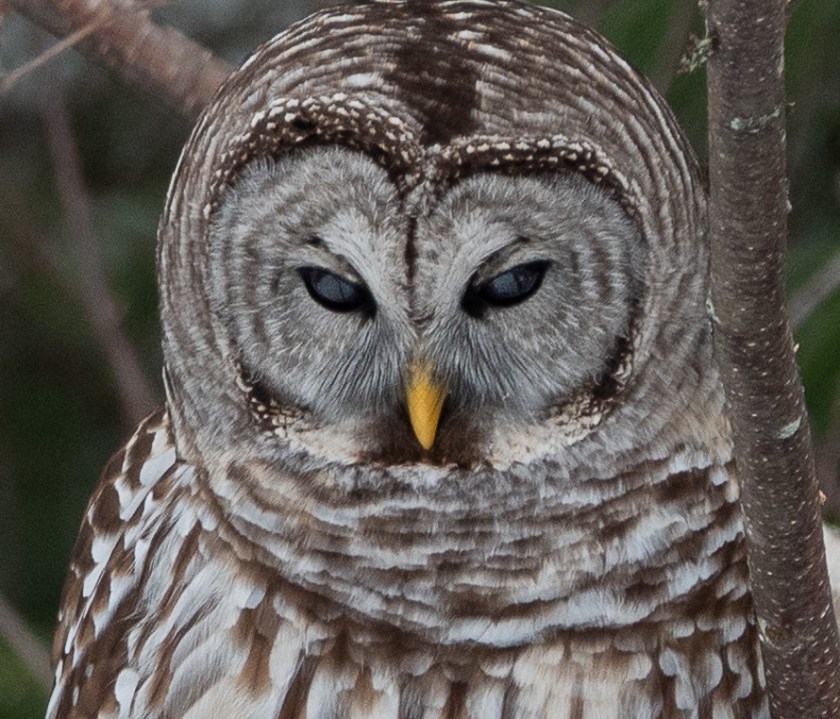[I promised you mammals this time, but then I met this owl… so the mammals have to wait a week.]
On August 12 2018 I posted about Barred Owls, Strix Varia, after I found a dead one on the road. This is a happier post, with photos of a splendid and very much alive example. It was perched on the phone lines above the road, and then flew into a nearby tree and settled in. Here it is, in all its glory:

Fully grown females can weight 2 lbs. They are mainly night hunters, so this one was just trying to catch up on sleep, next to a fairly busy road. But it kept a sharp eye on the ground below, and you can see that curved beak, and the stiff whiskers that are thought to help them sense the world around them, just like a cat’s whiskers do.

The heart-shaped concave facial disc of shorter feathers helps collect and direct sound towards the owl’s ears. For more details, see the end -note.
Although the beak may look ferocious, the real weapons are the feet:

The four toes ratchet closed, clamping firmly onto a branch and allowing it to fall asleep securely, but those same talons also grip the prey like scimitars, giving little hope of escape.
Winters here are cold, and Barred Owls do not migrate down south. Sensibly, their feathers form a personal down duvet that leaves little exposed beyond the very tips of the toes. The head and neck are covered in a luxurious cowl, fully visible here when its head is turned away:

Owls can’t move their eyes, so to look around they have to move their whole head. This owl has rotated its head nearly 180 degrees, and in fact it can go even further, 270 degrees.
On the same day I saw this owl, I had signed up for a wildlife drawing class to draw… OWLS! It was clearly a sign. Here is my screenshot of a Bengal Eagle Owl, taken during the class (www.wildlifedrawing.co.uk):

and here is my drawing:

I left my real owl in peace:

Note: Wikipedia says: The concavity of the facial disc forms a circular paraboloid that collects sound waves and directs those waves towards the owl’s ears. The feathers making up this disc can be adjusted by the bird to alter the focal length of this sound collector, enabling the bird to focus at different distances and allowing it to locate prey by sound alone under snow, grass, and plant cover.
Happy that you found a gorgeous Barred Owl & could share the beautiful photos. Your drawing of the Bengal Eagle Owl is excellent…looks like a small owl.
LikeLike
Stunning photos.
LikeLike
More drawings, love the drawing! Photos good too… >
LikeLike
Brava for the wonderful photos and drawing!
LikeLike
My God they are elegant creatures! And you did a wonderful job on your drawing I thought.
LikeLike